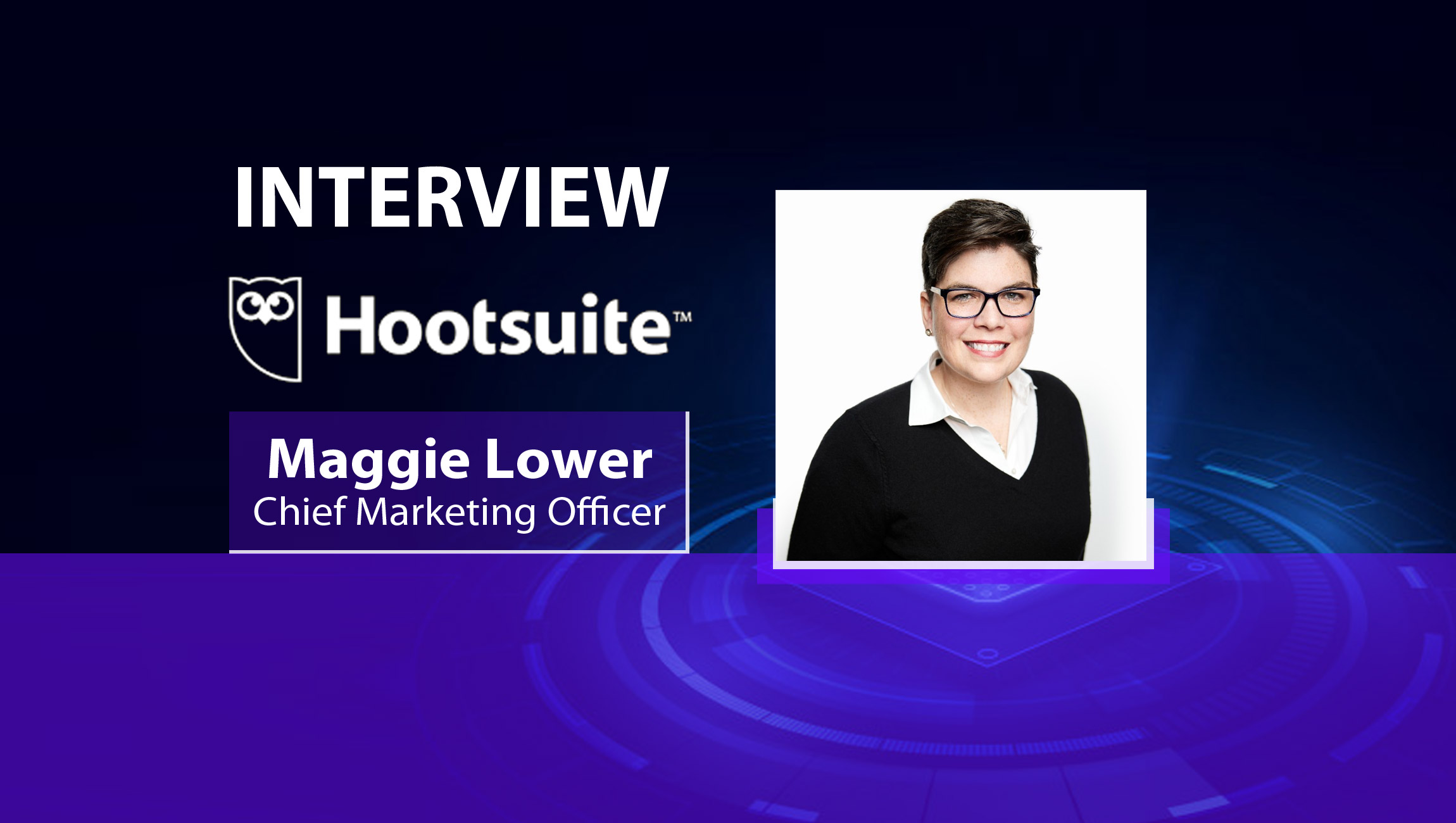Hootsuite recently welcomed Maggie Lower as their new CMO, we caught up with Maggie for a chat on her new role and how she forayed into marketing; catch the complete conversation where Maggie talks about a few best practices for today’s CMOs and what it takes to drive marketing optimizations in a dynamic business environment: _________ I didn’t start my career as a full-time marketer. I entered the corporate world in strategy and project analyst roles and I’m grateful for that experience every single day! From my earliest days in the job world, I’ve benefited from leaders who recognized my desire to try new things and my career took off from there. I’ve worked in financial services, human capital management and global staffing and recruiting industries in various commercial and leadership roles. I started taking on CMO roles when I joined Aon Hewitt in 2012 and led the team that launched the Alight rebrand as part of the spinoff to Blackstone. I then held the top marketing role as the first CMO at TrueBlue, and was most recently CMO at Cision. Personally, what I love about marketing is that it’s both left and right-brained in its full breadth—or what I often describe as equal parts art and science. I strongly feel that art is critical for awareness and recognition while science drives revenue growth and thoughtful customer connection ideally at scale. What drew me to Hootsuite was the chance to join a company that literally created a market and seems to be incredibly passionate about doing it. Four weeks in and I can report that my observation was correct. The Owls are incredibly passionate about the power and potential of social, I feel fortunate to work with such a dedicated global crew. Another important cultural differentiator at Hootsuite is that the leadership team is so talented and warm and the commitment to marketing was very clear as I was speaking to people in my assessment process. Marketing Technology News: MarTech Interview with Rodolph Barrere, Co-founder and CEO at Potloc Within the near future (and from a tactical perspective), I hope to support our growth with marketing driven global campaigns, while working with all of our internal partners to become the most highly desired place to work. I’d also like to have a clear plan on what we are doing to grow and what we will need to sunset or pause in order to achieve those aims. I imagine Hootsuite as a pace-setter on how to market in the new normal. I think we have to really hone our strategy at each stage of the funnel, be data-driven, pilot and test new approaches continually and further cultivate an approachable personality with the brand. The good news is that we have a lot of alignment at the leadership level around the culture that needs to continue to emerge to support this vision. I would wager that if you stood up four CMOs and asked them what Marketing Operations is, each one would give you four different riffs on what it means to them. There would be some commonalities to be sure, but several divergences as well. We have so much inbound volume in our particular business that I think the power in Marketing Operations, as we build it out even more fully, will be the team’s ability to clearly lay out fact patterns to help us make excellent capital allocation decisions across our full pipeline spectrum. The key pillars for Ops as I see it is that they own the MarTech strategy (particularly critical in global companies), they are deeply embedded in funnel reporting at each stage—so much so that they advise the CMO and their colleagues on what’s working or not working, and they are responsible to keep “silo-ization” and scope creep at bay, (i.e. process gurus). Terrific MarkOps leaders lay out governance, have a head for strategy and they have built the tech stack and analytics capabilities to back up that POV to drive success. Marketing Technology News: MarTech Interview with Brian Walker, Chief Strategy Officer at Bloomreach Never losing sight of the fact that B2B still means human to human. Challenging the notion that B2B marketing is boring and unemotional, that thinking is dated and intellectually lazy and I’m being kind. As marketers, we connect with people, so it’s our job to ensure our brand voice is approachable and conversational. As I said before, we need to have fun and be brave, creating a safe place for our teams to be creative. It’s up to us to lead that process to make sure our organization’s marketing strategy is in lock-step with the business strategy. To be the connection to the bigger picture. We do that by partnering closely with our colleagues across the organization in sales, product, support, and customer success in an effort to deliver a consistent customer experience. Customers don’t distinguish between departments and disciplines, it’s our job to foster a cohesive and collaborative approach that is seamless to the customer. And to do that, it means never taking our eyes off of our teams. Fostering the environment where the team succeeds collectively. People connect more with people than they do with brands—employees are our best advocates and most direct channel to our customers. Nurture that. You have to stay connected and communicate authentically. If you’re not having real conversations you’re not going to uncover true innovation – people have to feel safe to think boldly. I already view Hootsuite as a market leader, but I think we have an opportunity to be louder and really create more intentionality in the social care and social commerce space. We operate in a healthy market with compelling competition that I deeply respect. There is a lot of room to own the conversation around how to think about social business. I completely agree—it’s such a dynamic space that is constantly evolving and changing. You have heard that we recently acquired Heyday, a conversational AI leader that will enable our customers to have 1:1 conversations with their audience. More and more consumers (or people as we like to call them) want to communicate directly through messaging. We expect we will only see continued adoption of this trend which means that increasingly, customer care will be driven through social, and transacting business will happen directly in those channels. What we love about this is that we can listen to these channels and aggregate those insights to understand what people really want. The market will continue to drop clues about what it collectively wants without having to know how to make it happen – that’s our job: to listen, adapt and try to stay just a bit ahead without losing anyone in the process. Easier said than done, but it’s a worthy and invigorating challenge. I think the lines between B2B and B2C strategies will continue to meld when considering and activating social media strategies. B2B companies will have to consider their customer care and commercial approaches through the social media lens, and smart, humble leaders will realize that it might be a good idea to talk to their social media teams for ideas on how to go about this. Even now, you likely have resident talent and expertise, don’t overlook it and thereby under-leverage it because your buyers are human beings who are likely active somewhere on social media. I think within a few years we will be astonished that we weren’t leveraging the experiences possible. Social media will become a ubiquitous platform in the marketing toolkit – the insights gained and the business momentum that can be achieved with a considered social strategy will separate early adopters and innovators from the competition. Start building out your social media teams now, pretty soon they will be in high demand if they aren’t already! As I step into this position at Hootsuite, I want to be a part of taking some of the tarnish off of social media that has taken place over the last few years. Social is constantly evolving and growing. I had the opportunity to meet Google, Facebook, and Twitter executives about eight years ago as part of a small CMO junket where I was blown away at how these companies innovate, evolve, and grow. I think as these channels have grown, some of the big players have hit some rough patches in the court of public opinion, and there’s an opportunity to build it back up. I’m excited to really explore the parts of social media that drive change, joy, and cultural and commercial evolution and revolution. Marketing Technology News: MarTech Interview with Ross Negus, Enterprise Account Executive at Impact Maggie Lower, Chief Marketing Officer at HootsuiteWelcome to this MarTech Series chat Maggie, tell us more about yourself and your journey through the years…
In your new role as CMO at Hootsuite, what are some of the biggest plans you have in the near-future? As a marketing leader, what are some of the top 5 pointers you’d share with any CMO who is setting out to take over a new team?
Marketing Operations, more like easier, better marketing operations can help establish a stable marketing process for the team and enhance the experience for the end user as well: what are your thoughts on how marketing teams and leaders can bridge the gap here? What are some of the key aspects that should be basic everyday practices for marketing operations teams?
What makes for an all-round marketing executive in today’s B2B environment in your view?
As marketing platforms and martech evolves, disrupting the way marketing teams work and upskill themselves, how have you ensured your own teams have always kept up over the years?
We’d love to talk more about Hootsuite before we wrap up, it’s an exciting time for social media marketers today. In what ways do you feel marketers can optimize their end users social media experience in a more strategic way today?
A few thoughts on the future of social media marketing in the B2B marketplace?
Some last thoughts and takeaways?
![]() Hootsuite is a global leader in social media management, Hootsuite is trusted by more than 18 million customers and employees at over 80% of the Fortune 1000.
Hootsuite is a global leader in social media management, Hootsuite is trusted by more than 18 million customers and employees at over 80% of the Fortune 1000.
Catch the latest B2B Marketing and Sales Conversations with these latest episodes of The SalesStar Podcast Featuring Metadata.io, ON24 and more!
Episode 91: Top Trends And Concerns Of B2B Revenue Teams: With Sylvia Ananicz, Head Of Revenue At Lilt
Episode 90: Boost Your Customer Engagement And Marketing Process: Tips And Thoughts By Steve Daheb, CMO At ON24
Episode 89: Demand Gen And B2B Marketing Tips: With Gil Allouche, Founder & CEO At Metadata.Io











